For millennia, the red coral of the western Mediterranean Sea was fished by Romans, Arabs, Catalans, Provençals, Italians using simple tools. Single or crossed wooden beams called "Ingegni" (devices), ballasted by stones with long net pieces attached, crawled on the bottom or along the rocky walls to pluck the precious red twigs. You read it in our previous article. Centuries pass, systems change and today, coral is still fished as before. Since few decades we go and detach twigs one by one, on the sea bottom, with a collection system that is not new; in fact, we have news that some fishermen in the Roman age freedived to tear off the coral with a tool in the shape of a serrated hook. Then, there were various attempts in 1700 by fishermen lowering themselves to the bottom with an open bell and later, with the advent of the diving suit of the surface-supplied divers, real red coral hunts happened, especially by Greek divers.
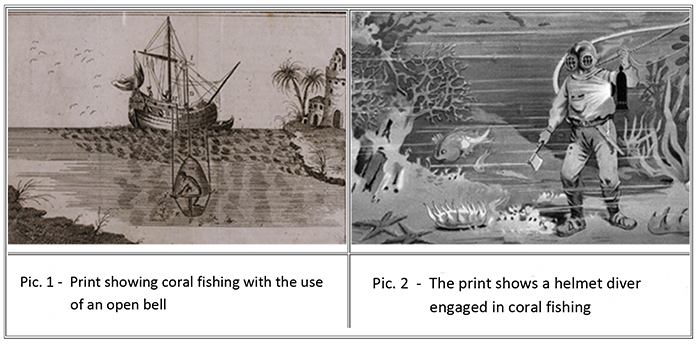 |
These old system limits were depth; at that time, it was difficult to dive below 30 meters. In 1946, Cousteau-Gagnan regulator arrived; for some, the change to this breathing system was rapid, also if equipment, technological and physiological knowledge were still primordial. During this time, dedicated ones must invent or modify their equipment daily however, when people realized that they could descend in the red gold mine of the sea bottom with oxygen rebreathers instead of the antique "device" with their own hands, many dedicated themselves to this activity. A caste of adventurers developed; they were people prompted by possible earnings and the research of unknown feelings, with a unique lifestyle who started what we will remember as the "coral fishermen epic". It seems that all began at Palinuro Cape by an instructor of the Méditerranée Club, the French J. P. Broussard and Leonardo Fusco. In the waters of the Campania region in Italy, they will be immediately followed by da Alberto Novelli, Ennio Falco, Claudio Ripa, Guido Garibaldi and Fausto Zoboli in Ligurian and Tuscan waters, while other groups formed in Spain and France. In this time, it was the beginning of 1950, depths were not yet considerable, and coral was found at depths even lower than 30 meters. Gear was simple; besides the basic one it included a double tank filled with 150 bars, one regulator, the peg or "maleppeggio", one small board and one "coppo", a straw or net basket opened by a round iron ring. Sometimes, divers wore old sweaters to protect from cold and from rock scraping, while depth gauge was not always available, nor watch. Depth values were measured by a sounding hand lowered by the boatman; a hardened regulator because of the tank pressure reduction was the indication during ascent. For air autonomy and time, a simple calculation was made; to multiply for two the depth given by the sounding, adding the fixed value of 20 equal to the air consumption/minute; at the end, the air volume in the tanks was divided with the obtained result. Example: a dive at 40 meters with a 10+10 double tank filled with 150 bars, thus containing 3000 normal liters of air; the consumption’s calculation is 40+40+20 = 100 liters per minute. By dividing liters in the double tank with the consumption liters we calculate the dive time, that is 3000:100 = 30 which correspond to the dive minutes available to our coral fisherman.
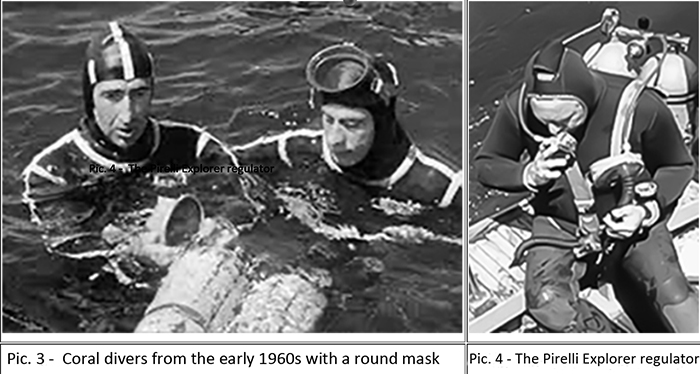 |
With regards to decompression, divers’ knowledge was real minimum; an undefined decompression was made, performed differently by each diver. In this time, coral desire pushes many to hunt for good luck towards what they considered to be the more profitable places; this is begin of the run to the Sardinian coral. Leonardo Fusco, Ennio Falco, Claudio Ripa arrive to Alghero, more precisely to Caccia Cape where they find plenty of coral in small depths. Here it comes the first victim of the "red gold fever"; Guido Garibaldi dies. It was recovered together with his basket and maleppeggio, wearing only a thick felted wooden sweater. After pioneers’ experiences, most of coral fishermen concentrateion the Bocche of Bonifacio with their base in Santa Teresa of Gallura. In these waters there is a coral that in Torre del Greco, the world’s capital of coral market is sold at the highest price. It is a dark red coral (with some pink exceptions), massive, healthy, rarely «knobbed», of high specific weight and with long trunk, instead of bushes such as the Spanish or Ligurian one, excellent for manufacturing. Its medium branches can weight up to one or two hectograms; thicker branches up to half a kilogram; extraordinary branches can also reach one kilogram.
Newcomers had to face some problems linked to location characteristics, with deeper dives compared to their previous standard ones, to be made in open sea, often wept by strong winds and currents, and impetuous waves. Boats had to have a length of at least 10 meters, stable but fast, equipped with echo sounder. One of the first thing which became of normal use was the suit, often wore two at the same time, one on top of the other to better protect them from cold during long decompression stops; then, bigger tanks filled with 200 bars, thanks to the new compressors. Several divers began to use at least the watch, while depth gauge is still considered superfluous by many, considered that echo sounder gives depth. For decompression, divers refer to a ballasted rope lowered from the boat with marks in the different stop levels. The idea of a second regulator begins to make its way; the small single tube ones have recently arrived, almost simultaneously with the expanded neoprene suits.
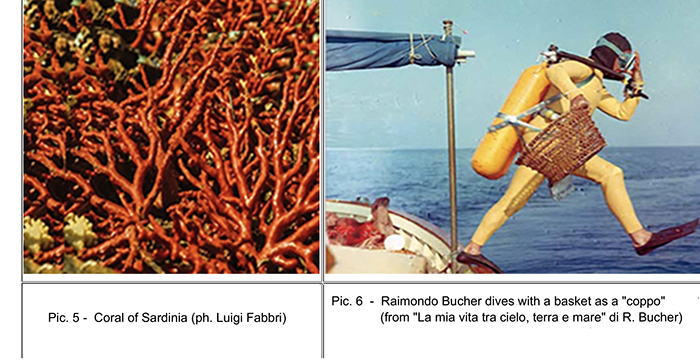 |
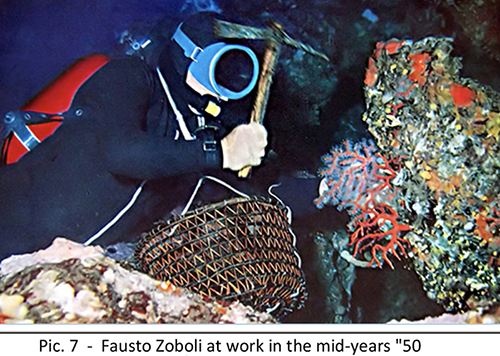 |
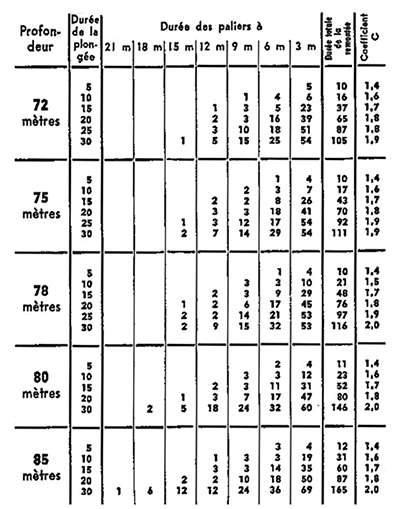 |
|
Pic. 8 – Extract of air tables of GERS in 1965.
|
However, while neoprene suits immediately show their validity, the first single tube regulators are far away to have performances and reliability of their two-tube cousins, these last ones impossible to assemble as a couple; so, divers still must wait a long time before this idea is feasible. One issue that occurred immediately was the need of having a diving light, fixed in the head or in the harm holding the coppo, which became essential to fight the half-darkness of high depths and the total dark of ravines and small caves. To make long decompressions more comfortable, systems are installed in the boat which allow to supply hot water to divers. Water arrives by means of a hose to place under the suite or between two suits, lowered with a ballasted rope. Considered the depths, a feature is that weight belt is not wore, substituted by some stones positioned in the coppo, removed by the diver during his descent. With regards to the dive plan nothing changes; for an unwritten rule dictated by experience, coral fishermen prefer solo dive, with shifts if they are a team. From the safety point of view, what really matters is the sailor who must follow the divers, without ever losing sight of their bubbles, and intervene upon arrival on the surface of the board to organize the decompression. Decompression is now made with consolidated procedures, thanks to the greater awareness of physiological problems and the spread of decompression tables, even if these are considered more a trace to be interpreted with personal criteria. As it happens in this special world, innovations are accepted not to reach a higher safety level, but for the offered possibilities of a tempting bigger profit that, in this case, is located deeper and deeper. In the middle of 1960, the first triple tank bottles appear.
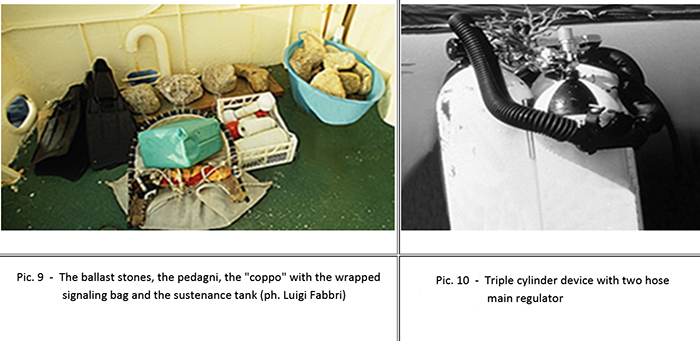 |
Diving gear was usually formed by a regulator and two tank bottles of 12 or 15 liters with reserve, plus a smaller bottle of five or ten liters equipped with one single-hose regulator; those with more knowledge, filled them with oxygen instead of air. In fact, a study of Doctor Gaspare Albano said that decompression times breathing pure oxygen could have shortened of almost 50%, while for the French Navy it was 40%. In the 60s, the whip pressure gauge and Sos decompression gauge appear; boats become bigger and more comfortable, so that in his boat Leonardo Fusco installs a hyperbaric chamber. Another big innovation is the introduction of the holding systems both of coppo and the diver. For coppo, they began using an overturned bucket filled with air; to equilibrate it in depth, they used a bag of rubberized canvass tied to the second stage of a single-hose regulator, by adding the needed air. Later, for a suggestion of Commander Bucher, it will be also used as lift to bring the diver to his decompression stop without finning. Buoyancy jacket didn’t exist. In this period, a terminology proper of coral fishermen is born, suitable to indicate different points or the bottom characteristics. Small isolate rocks in a flat bottom or in a slight slope are called «Scoglietti»; monoliths with a structure of Dolomite spiers, about ten meters high, take the name of «Spicarielli»; rocky walls which drop with jumps of 5-15 meters in a second plain bottom are named «Pettate»; the very wide, terraced slopes, which often border the extremities of an underwater canyon and can lead to very high depths are the «Scalomate». A bottom section where divers already went become "Ripassata", as the area where coral is fished twice is "Macchia". Let’s see now how the dive was planned. Fishermen dived regularly breathing air at 80-90 meters; at this depth, bottom times are forcefully quite limited because of consumption, around 15-20 minutes. Once geared with the help of the seaman, diver jumps in water with all his tools to work. Descent begins quite slow to become faster, so he starts to remove some stones from the coppo to get lighter, until he reaches the bottoms where he discharges all his ballast. If he is lucky, he initiates immediately to pick and drop the small branches in the coppo, to be equilibrated with air in an overturned bucket or a tank opened in its bottom.
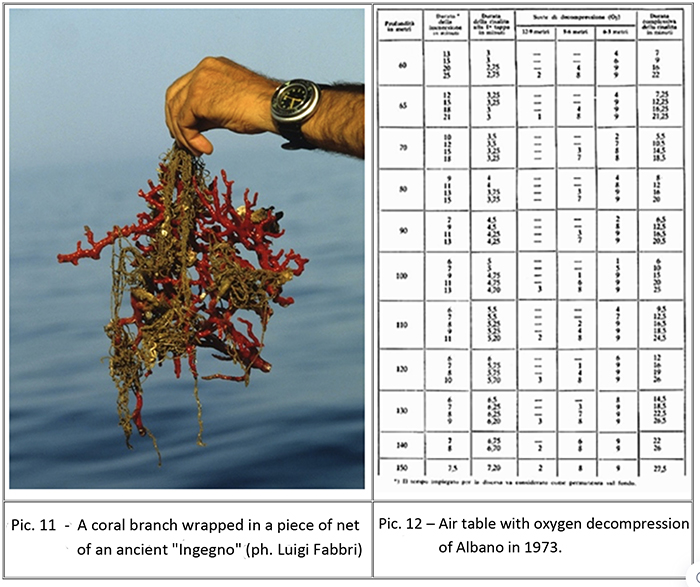 |
Once collection is finished, if the diver believes that this site is productive, he launches his board to fix the point of his next dive, and begins the most sensitive part, his ascent. He can do it in two ways: finning or using a bag of rubberized canvass as lift, as we read before. In any case, he is careful not to never exceed his bubbles speed; arrived at 30 meters, he drops the bag and immediately stops. The seaman, having seen the diver’s bag, positions the boat on top of him, and lowers a new group of bottles attached to a weighted belt that the diver must wear, then the hot water hose, one rope to recover the coppo, one small board with a pencil to communicate during the long stop. Now decompression begins which many conduct in the following way: first dive between 75 and 80 meters, bottom time of 15 minutes, ascent to 30 meters. Change of bottles and very slow ascent up to 18 meters, then stops at 18, 15, 12, 9, 6 and 3 meters for approx. 40 minutes of total runtime, preferring a higher stop time at 9 or 6 meters, to be less affected by the wave motion. Those who used oxygen in their last decompression part, change air to oxygen at around 12 meters, cutting planned times of about the half, always preferring the higher stop at 9 or 6 meters. Dive interval is generally of three hours, with average decompression times of 60 minutes for the first dive and 90 minutes for the second dive; in some cases, these figures are doubled. Considered that, in areas where coral divers worked there were rare hyperbaric chambers, in case of "pizzicata" as light DCI (decompression illness) of type 1 was called, usually underwent to a second decompression treatment in water.
Serious, or less serious accidents related to this red gold hunt unfortunately begin to be heavy; working depths are higher and picking at 90 or 100 meters is quite frequent. At the end of the 60s, beginning of the 70s two well-known deaths happen. In 1969, Ennio Falco dies while in 1973 is the turn of Cesare Olgiay, so of the famous group of coral divers in the Mediterranean Sea only Alberto Novelli remains. Seen these continuous accidents continuously happening among the coral community people begin to acknowledge that responsibility is the working higher depth but, as the main accused is finally identified air that, breathed at higher pressures, become toxic. The following period see the raise in this specific world of the first synthetic helium-oxygen mix users. Despite coral divers have never been used to complications, their approach is professional, being trained with specific and extremely expensive courses, held by specialized companies such as Comex. This revolution was possible thanks to the ability of some people to change their mind, among those the first are Leonardo Fusco, Fausto Zoboli, Giovanni Ascione and few others; mainly, this change happened because there was a generational jump. A group of young people made their way, such as Antonio Murru, Tore Lai, Mario Bulciolu, Piero Capula and others who will operate for the next forty years, until the beginning of the new millennium. Coral diver did not change much their dive technique with the first approach to synthetic mixes; however, now some rules must be followed, one of which is oxygen decompression. Above all, divers must have a system able to fill bottles with mixes, which increased in their volume and number, up to five.
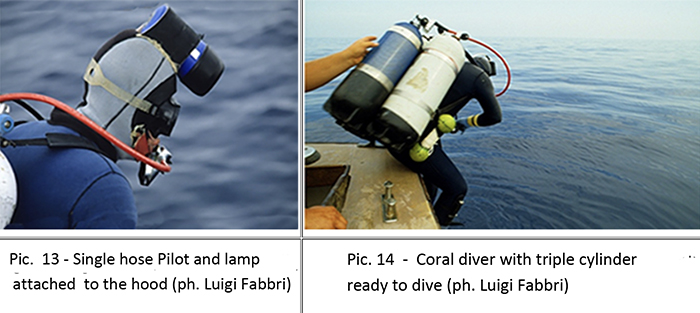 |
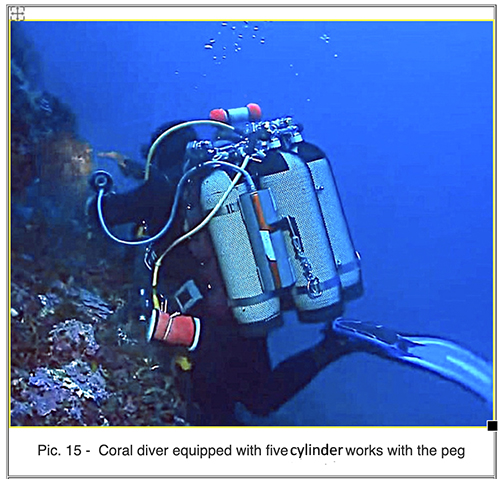 |
Before continuing our journey, it is necessary to underline the different approach to mixes compared to what happens now in the technical-recreational sector. First of all, coral divers used only one bottom mix and a flexible table, valid for a quite large depth range, since they did not know at which exact depth they were making their search: it could have been at 70 meters set by the sounding or nearby, in a cave at 90 meters. Very different are also the decompression methodologies preferred at the beginning of 1980 until at least the end of the following decade.
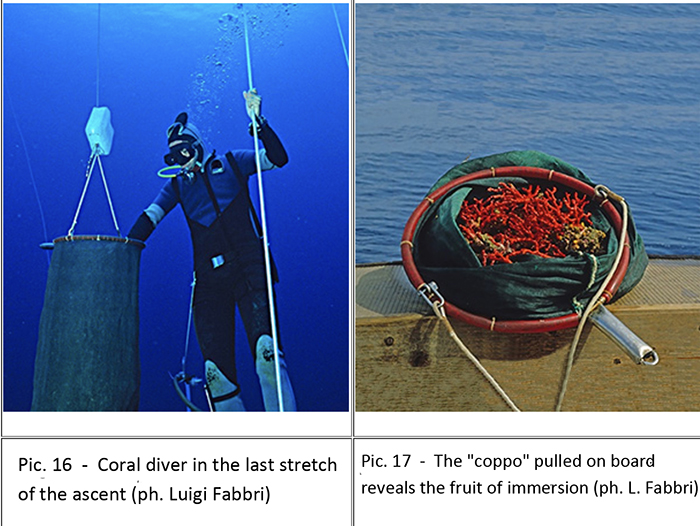 |
Let’s examine which is the typical decompression of the coral diver with a tri-mix. He slowly begins his ascent from the bottom; at 60 meters he launches his board to inform the seaman about his position. Then, everything’s proceeds as we saw earlier except that now, at 50 meters, he switches his mix to breath air from the double tank lowered from the boat, thus making the first part of his decompression, ascending step by step. Once he arrives at 15 meters, he switches to oxygen from the hose lowered by the seaman, following the times to surface of that specific table, until that moment. Once on the boat, he still breaths oxygen for at least 30 minutes without making any effort, carefully monitoring any DCI symptom could happen. An alternative to this procedure is to follow the decompression system on the surface, called "jump". In this case, at 30 meters he switches to a nitrox mix from a bottle lowered from the boat, he removes his double tank that the seaman recovers with a rope, and the diver ascents in the set times up to 12 meters, where he switches to oxygen. Once the planned stops are concluded, he surfaces and, in the boat, he continues to breath oxygen, quickly undressing to enter the recompression chamber installed on board. This chamber is pressurized at the depth of 12 meters; decompression is run according to the table, often customizer.
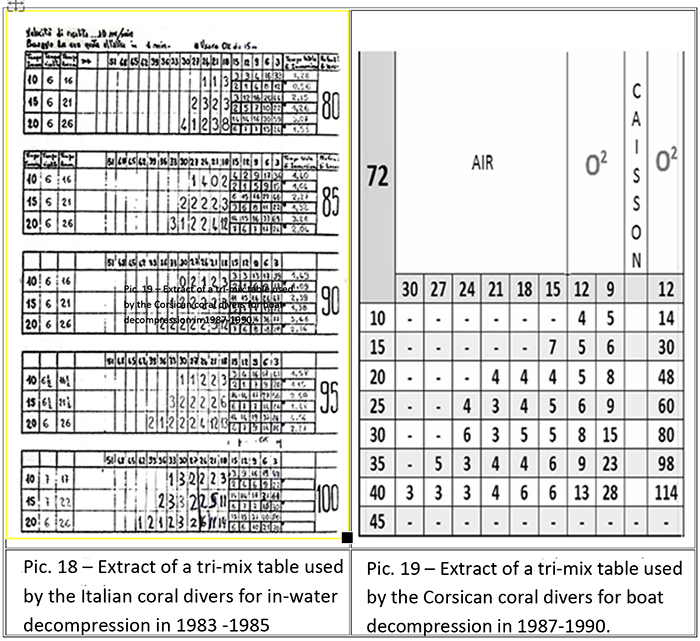 |
Of course, the decmpression tables reproduced in these pages today are considered dangerous and absolutely
prohibited by any agency.
If the arrival of mixes lead many to leave because of the new needed gear to buy and old habits to change, on the other hand someone did not stop and began to evolve further. Leonardo Fusco, already a pioneer with mixes, in the middle of 1970 test a rebreather, one Dräger Fgg III with semi-closed circuit that he modified, that he will use regularly. To push him to this choice was the awareness that, with 5 bottles in his shoulders, his movement capacity underwater was at the limit.
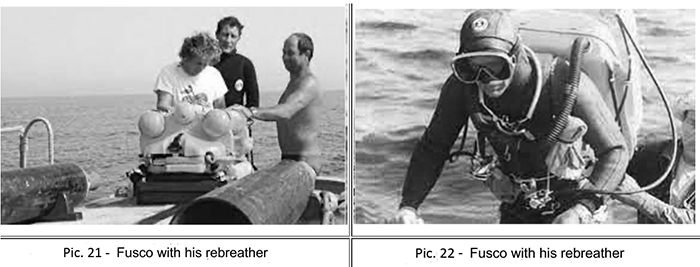 |
The couple Antonio Murru and Mario Bulciolu followed Fusco’s example, while most of coral divers remained with their open circuit, easier and simpler to manage. In the meantime, the red gold hunt has an increase with the discover of large coral quantities in the Skerki bank, in the middle of Sicily channel. In the first years of 1980, expert divers and improvised coral divers jump into it, with base in Trapani which, for some years, became the coral capital, as in the past.
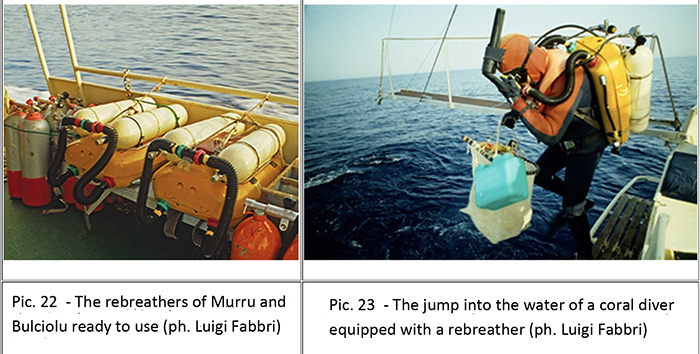 |
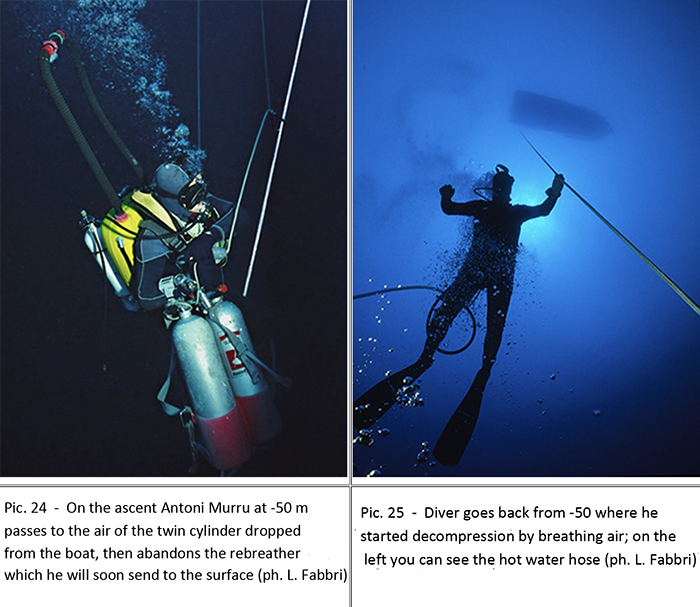 |
From a technical-organizational point of view it seems that there is an arrival point; tri-mixes imposed, and all boats have their recompression chamber, considered that ending the decompression on the boat became a standard practice. The next decade registers a substantial continuity; coral divers spread in Algeria, Tunisia, and other places but the main location remains S. Teresa of Gallura. Its unique boats make a long line in the evening, docked on the sides of the big and famous one of Antonio Murru. People begin now to think to the use mini submarines and robots, devices immediately stopped by new rules. At the beginning of 2000, another possible revolution knocks on the door, fostered by the entrance of the electronic closed-circuit rebreathers in the sport sector. However, thee way a coral diver dive does not suit too much the inflexibility of a device that, for its nature, needs continuous attention and rules, consequently not too many adopt it. In the meantime, coral is far less researched than before, not fashionable anymore and, together of this awareness, bureaucratic and huge handling costs sum up. Consequences of such a situation are unavoidable; active coral divers are always less and this millennial job to collect red branches offered by the sea seems to be arrived at his sunset.
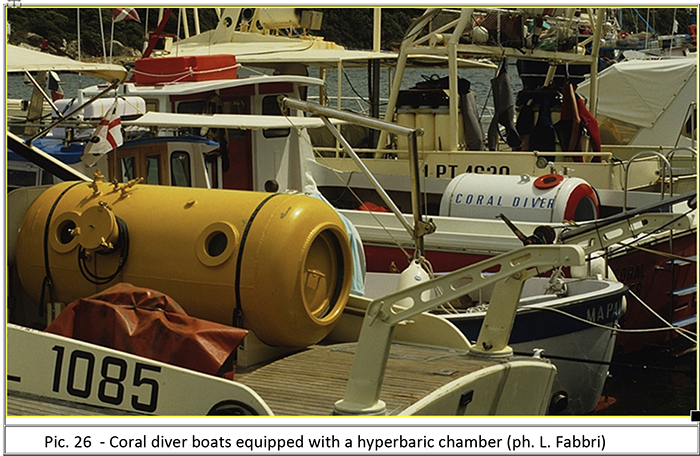 |
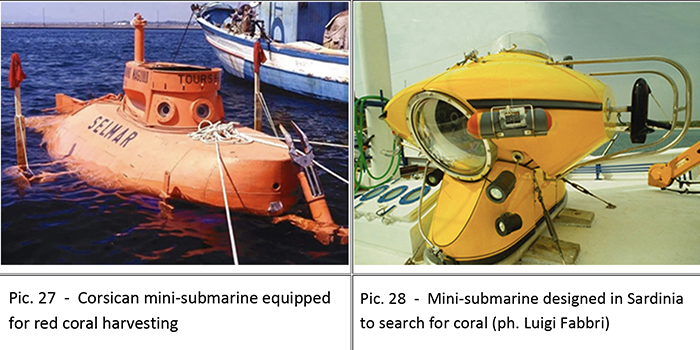 |
From the film "The coral divers of Corsica" of Jacques Yves Cousteau 1963
______________________